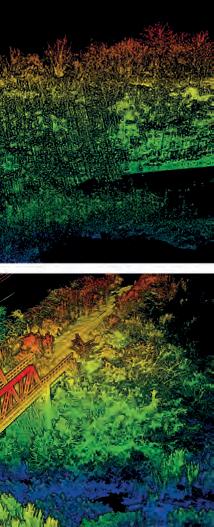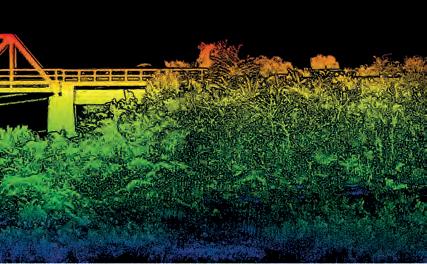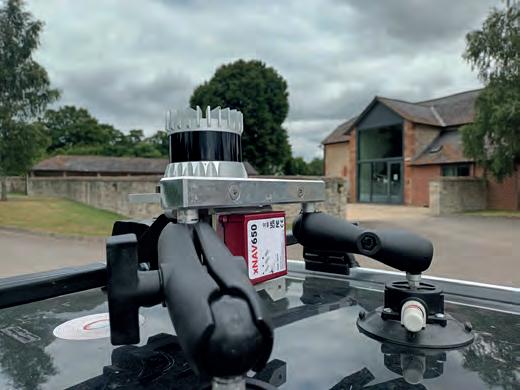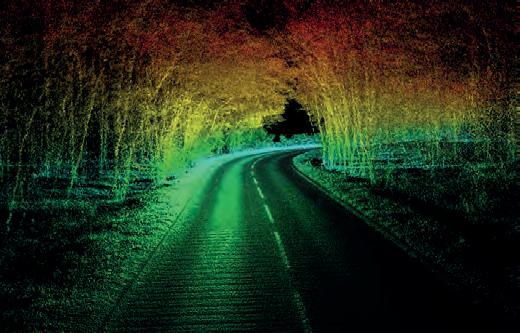
6 minute read
Sensor fusion is key to improving data quality in poor GNSS conditions Using Lidar to enhance urban navigation data quality




By Paris Austin, OxTS
At OxTS, in line with our brand promise of being inertial navigation experts, our commitment to our customers is that we will keep innovating until we can help them truly ‘navigate anywhere’ – with or without GNSS. We are advancing our products in that direction by first enhancing urban navigation data quality based on sensor fusion. Here, we explain how.
Without accurate positioning and orientation in all environments, many autonomous navigation and surveying applications are impossible to execute to the required level of quality. Whether for an advanced driver assistance (ADAS) feature validation test on the open road or a mobile mapping application to create HD maps of an entire city, navigation data is at the heart of ground-truthing and georeferencing applications. Without it, our customers would be unable to produce data with centimetre-level absolute accuracy in the global frame, preventing them from going to market with an ADAS feature or selling map data to their own customers.
Although customers do not obtain perfect GNSS on the open road and in dense urban environments, they require similar levels of accuracy to what we deliver on an automotive proving ground. With our innovation work in 2023 and beyond, we therefore plan to offer improved navigation performance in such environments. Through this work, we will bring our customers closer to the goal of OxTS – which is to help them ‘navigate anywhere’ – as well as extending our capability to more customers in new applications.
Sensor fusion
Sensor fusion is at the heart of all of our navigation work. The fusing of GNSS and inertial measurement unit (IMU) data originally gave OxTS the traditional inertial navigation system (INS) product that has served our customers for two decades. The addition of a wheel speed sensor in current applications enables further enhancement to navigation performance, but more sensors than ever before are available and have the potential to aid the navigation solution we are offering. Using sensors with mutually exclusive sensing approaches means that error growth manifests in a way that allows for reliable validation and redundancy. If four sensors agree and one contradicts with them, it is an easy decision to reject the outlier. This is often better than using five of the same sensor with common error characteristics, since if one suffers a drop in performance based on an event, they all could.
Paris Austin is head of product – new technology at OxTS. During his more than ten years of service at OxTS, he has taken on multiple roles within the Support and Application Engineering teams, giving him in-depth insight into customer use cases. Having made the move out of engineering into a business-focused role, he has been responsible for starting dedicated business functions to launch Lidar survey-specific products. He is now looking to the future of OxTS technology to ensure the products remain on the leading edge of navigation capability and continue to solve real-world customer problems.
Much more robust
The first step is to pick a sensor with mutually exclusive characteristics to GNSS and IMUs. Lidar’s growth in popularity for autonomous and survey applications means that Lidar sensors are prime candidates as aiding sensors due to their increasing performance levels and decreasing cost. The 3D nature of operation means that Lidar can be utilized to identify features in a complex environment over time and calculate a velocity vector. This can be used to constrain IMU drift in all axes of velocity through odometry updates, allowing for enhanced dead reckoning in GNSS-denied environments. Pair this with the advanced GNSS processing of OxTS’s gx/ix algorithm and in-house IMU design, and the navigation solution becomes much more robust in a GNSS-restricted environment.
INS and Lidar have a number of mutually exclusive characteristics. Using Lidar to aid navigation is the next step in OxTS’s ‘navigate anywhere’ mission.



Further information
If you’re interested in learning more about using sensor fusion to ensure position accuracy in all environments, contact us at info@oxts.com to arrange a confidential conversation about your project.
7 questions about the sensor fusion development journey at OxTS
1. What is the history of OxTS and what has led the development to this point?
OxTS has been delivering high-quality real-time inertial navigation systems to the market for over 20 years. Grounded by a strong technology development culture, we have been providing solutions to enable our customers to complete their work in many environments all over the planet. Sensor fusion as a concept has evolved over time, initially meaning just GNSS and IMU fusion, but now leading to more and more sensors being integrated to achieve a true ‘navigate anywhere’ goal.
best combination of sensor fusion will always be one of contrasting individual sensor capabilities. For example, whereas GNSS is low update rate and noisy (by comparison to its counterpart), an IMU is high update rate and very smooth output. Pairing them together gives a great result. Extend this to where Lidar and visual systems work well (e.g. urban environments) and this is a great match for GNSS. In environments where satellites are hard to detect and track reliably, a mutually exclusive sensor update is needed to help navigate to a high level of accuracy.
2. Why is it important for OxTS to help customers
‘navigate anywhere’
We believe our technology is transferrable to so many different applications while the core offering remains the same: navigation data. It doesn’t matter what your end goal is, if you need to know when/where you were at any point during your session, then we can enable that data to be provided in an easy-to-consume way, eventually leading to an intelligent, data-driven decision to be made.
3. What is sensor fusion?
The human senses are a brilliant example of sensor fusion. Vision, hearing and touch (and even smell and taste) can all help us ‘locate’ where we are and navigate from A to B. When one of those senses fails or is underperforming, the others are able to keep us on the right path – maybe not to the same level of accuracy, but maintaining a safe level of travel so that we can still get to our destination. To us at OxTS, sensor fusion is the integration of multiple sensors of different capabilities and operating characteristics (GNSS, IMU, WSS, etc.) to fuse their data intelligently, taking the best and discarding the worst data from each sensor. This can be done through sensor modelling and calibration, allowing the decision-making within the sensor fusion engine to know when to trust or distrust each sensor. More sensors mean a more complex – but also more robust – calculation that allows for operation in harsher navigation environments.
5. Which combination of sensors can be used in a sensor fusion ‘framework’?
The key is to strike a balance of engineering investment, time and cost of components to avoid diminishing returns. Using ten GNSS receivers would not give us ten times the performance of one GNSS receiver, so it does not make sense to use multiple receivers. But by pairing together two low-cost sensors that have different operation and error characteristics, it’s still possible to achieve better navigation performance in the environment you care about. A €4,000 GNSS receiver would be far better than a €10 GNSS receiver in a patchy but not totally denied GNSS environment. However, if we used the €10 GNSS receiver and a €10 IMU under a bridge or in a tunnel, we would still achieve better performance than the €4,000 GNSS receiver, which would give no output at all in this environment. There is also the practicality of building reliable hardware and calibrating it. Performance may be achieved for the purpose of a whitepaper, but the ability to reliably manufacture and ship systems that deliver consistent results for all of our customers is a big factor in what sensors we put into our products.
6. What results have been gained from the development tests so far?
4.
How can sensor fusion help OxTS to achieve its ‘navigate anywhere’ mission?
Sensor fusion allows us to break free from the simple navigation environments where a single sensor like an RTK GNSS receiver can do the majority of the job in open sky conditions. With the fusion of the IMU, we were able to seamlessly handle short to mid-term outages of GNSS. With the addition of wheel speed data, we can extend that duration even further. If we add additional aiding, such as Lidar or visual odometry, we can correct the IMU error over time while GNSS is absent to prevent error build-up and improve our dead reckoning even further. As a result of using these enhancements, we aren’t very far off the true path when good-quality GNSS returns. The
The latest work at OxTS has seen us prove that Lidar is a viable aiding source to the sensor fusion engine. Offering a 3D velocity update to help the INS in a GNSS outage, it improves dead reckoning performance in 3 axes and will allow our users in urban environments to get better ground-truth and mobile mapping data for their current and future projects.
7. What does the future hold for OxTS development in this area?
We are continuously iterating on this integration of Lidar as an aiding source with an internal roadmap of work that will lead to stronger open-road data collection performance over time. This work is currently focused on delivering in the post-process environment where our customers care about getting the best possible accuracy and where the immediate consumption of processed data is not required while still in the vehicle.
Trimble Dimensions+ User Conference 2022











